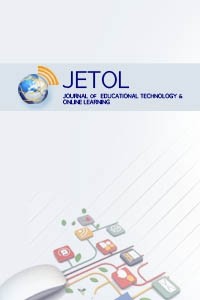Discourse on student participation in the Open Distance Learning using Open Educational Resources
Discourse on student participation in the Open Distance Learning using Open Educational Resources
Open and Distance Learning,
___
- References Anderson, T., Rourke, L., Garrison, R., & Archer, W. (2001). Assessing teaching presence in a computer conferencing context. Journal of Asynchronous Learning Networks, 5(2), 1-17. doi:10.24059/olj.v5i2.1875
- Butcher, N., & Moore, A. (2015). Understanding open educational resources. Burnaby, British Columbia, Canada: Commonwealth of learning.
- Cannella, G. S., & Lincoln, Y. S. (2007). Predatory vs. dialogic ethics. Qualitative Inquiry, 13(3), 315-335. doi:10.1177/1077800406297648 Common Wealth of Learning. (2015). Guidelines for open educational resources (OER) in higher education. Paris: United Nations Educational, Scientific and Cultural Organisation.
- Cox, G., & Trotter, H. (2017). Factors shaping lecturers' adoption of oer at three south african universities. In C. Hodgkinson-Williams, & P. B. Arinto (Eds.), Adoption and impact of OER in the global south (pp. 287-348). Cape Town: African Minds. doi:10.5281/zenodo.1094852 Retrieved from https://search.datacite.org/works/10.5281/zenodo.1094852
- Fischer, H., Heise, L., Heinz, M., Moebius, K., & Koehler, T. (2015). How to identify e-learning trends in academic teaching. Interactive Technology and Smart Education, 12(1), 31-43. doi:10.1108/ITSE-09-2014-0031
- Garrison, R. D. (2017). E-learning in the 21st century: A community of inquiry framework for research and practice (3rd ed.). London: Routledge. Retrieved from https://search.credoreference.com/content/entry/igidl/communities_of_inquiry_in_online_learning/0
- Garrison, R. D., & Anderson, T. (2003). E-learning in the 21st century: A framework for research and practice. London: Routledge/Falmer.
- Johnstone, S. (2005, ). “Open educational resources and open content, background note”,
- Maritim, E. K., & Getuno, D. M. (2018). Scalability of learners’ success rates in e-learning: A survey study of the learners’ perspectives. European Journal of Open, Distance and E-Learning, 21(1), 1-15. doi:10.2478/eurodl-2018-0001
- Materu, P. N. (2004). Open source courseware: A baseline study. Washington, DC: The World Bank.
- McGrea, R., Miao, F., & Mishra, S. (2016). Open educational resources: Policy, costs and transformation. In F. Miao, Mishra Sanjaya & R. McGreal (Eds.), Open educational resources:Policy, costs and transformation (pp. 1-12). Paris: UNESCO.
- Moore, A. H. (2002). Lens on the future: Open-source learning. EDUCAUSE Review, 37(5), 42. Retrieved from https://search.proquest.com/docview/218195918
- Mortari, L. (2015). Reflectivity in research practice. International Journal of Qualitative Methods, 14(5), 1-9. doi:10.1177/1609406915618045
- OECD. (2007). Giving knowledge for free: The emergence of open educational resources. (). Paris: OECD. Retrieved from http://apo.org.au/?q=node/16547
- Pitsoe, V., & Letseka, M. (2018). Access to and widening participation in south african higher education. In J. Hoffman, P. Blessinger & M. Makhanya (Eds.), Contexts for diversity and gender identities in higher education: International perspectives on equity and inclusion (pp. 113-125). Bingley, United Kingdom: Emerald Publishing Limited. doi:10.1108/S2055-364120180000012009 Retrieved from http://www.emeraldinsight.com/10.1108/S2055-364120180000012009
- Santally, M., Cooshna-Naik, D., Conruyt, N., & Wing, C. (2015). A social partnership model to promote educators' development in Mauritius through formal and informal capacity-building initiatives. Journal of Learning for Development, 2(1) Retrieved from http://hal.univ-reunion.fr/hal-01375627
- Santosh, S., & Santosh, P. (2016). Use of open educational resources in distance education-opportunities and challenges in indian scenario. Staff and Educational Development International, 20(1), 39-54. doi:10.1080/01587919.2012.692068
- Seawright, J., & Gerring, J. (2008). Case selection techniques in case study research: A menu of qualitative and quantitative options. Political Research Quarterly, 61(2), 294-308. doi:10.1177/1065912907313077
- Wolfenden, F., Auckloo, P., Buckler, A., & Cullen, J. (2017). Teacher educators and oer in east africa: Interrogating pedagogic change. In C. Hodgkinson-Williams, & P. B. Arinto (Eds.), Adoption and impact of OER in the global south (pp. 251-286). Cape Town: African Minds. doi:10.5281/zenodo.1094850 Retrieved from https://search.datacite.org/works/10.5281/zenodo.1094850
- ISSN: 2618-6586
- Yayın Aralığı: Yılda 3 Sayı
- Başlangıç: 2017
- Yayıncı: Gürhan DURAK
Mobile Learning in Turkey: Trends, Potentials and Challenges
Gönül ÖZSARI, Abdullah SAYKILI
Design Thinking Applications in Teaching Programming to Gifted Students
Yunus Emre AVCU, Kemal Oğuz ER
Sentiment Analysis for Distance Education Course Materials: A Machine Learning Approach
Usame Ömer OSMANOĞLU, Osman Nuri ATAK, Kerim ÇAĞLAR, Hüseyin KAYHAN, Talat CAN
Negative Aspects of Using Social Networks in Education: A Brief Review on WhatsApp Example
Burak YILMAZSOY, Mehmet KAHRAMAN, Utku KÖSE
Discourse on student participation in the Open Distance Learning using Open Educational Resources
Ramashego Shila Shorty MPHAHLELE, Matlala MAKOKOTLELA
Successful implementation of E-learning in self-financed Higher Education: Experience from Hong Kong
